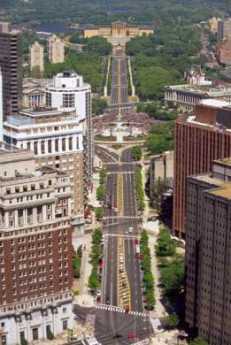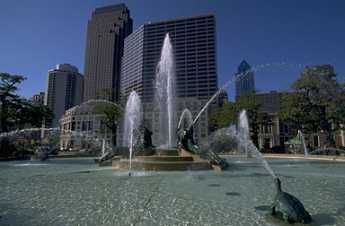Related Topics
West of Broad
A collection of articles about the area west of Broad Street, Philadelphia, Pennsylvania.
North of Market
The term once referred to the Quaker district along Arch Street, and then to a larger district that had its heyday after the Civil War, industrialized, declined, and is now our worst urban problem area.
Particular Sights to See:Center City
Taxi drivers tell tourists that Center City is a "shining city on a hill". During the Industrial Era, the city almost urbanized out to the county line, and then retreated. Right now, the urban center is surrounded by a semi-deserted ring of former factories.
City Hall to Chestnut Hill
There are lots of ways to go from City Hall to Chestnut Hill, including the train from Suburban Station, or from 11th and Market. This tour imagines your driving your car out the Ben Franklin Parkway to Kelly Drive, and then up the Wissahickon.
Benjamin Franklin Parkway (1)

|
| B. Franklin Parkway |
Philadelphia has straight streets and square blocks in all directions, by the hundreds. Just a few streets slant off at an oblique angle, and most of those, like Germantown Avenue, is following old Indian Trails. The one, cold-blooded, deliberate slant street is the Benjamin Franklin Parkway which essentially runs from City Hall to the acropolis holding the Art Museum aloft. Just whose idea it was is unclear, although the architect Horace Trumbauer gets most credit. The actual design was given to a Frenchman, Jacques Greber, presumably because it imitates the effect of the Champs d' Elysee in Paris -- a broad sweeping boulevard with lanes of trees along the side and in the medians. As things turned out, a simple idea was pretty hard to put into practice. First of all, plenty of people in Philadelphia don't like anything if it's French, and an even larger number don't like the idea of messing around with our nice traditional system of squares at taxpayer expense. The people who lived in the area were naturally upset to see the ends of blocks chopped off, destroying the corner property entirely and exposing the backyards of the neighbors to public view. At the beginning of the Twentieth Century, the Pennsylvania Railroad's Chinese Wall cut off the center of town from "North of Market" , and the Parkway thus created a triangle of desolation that could only recover when the Swan Fountain appeared, named

|
| Swan fountain |
after the President of the Philadelphia Fountain Society. The sculpturing was done by Alexander Stirling Calder, the son of the sculptor (Alexander Milne Calder) of William Penn atop City Hall. The original design made the mistake of planting all the trees as red oaks, and so most of them died of the same disease at the same time, requiring replacement with mixed varieties of trees that would not be so susceptible to epidemics. People were reluctant to live in the isolated triangle of land to the South of the Parkway, and also in the strip of land North of the Parkway up the steep hill to Eastern State Penitentiary on Fairmount Avenue. Accordingly, the land was filled with public buildings, including the semi-prison for adolescents, the Central Detective Bureau, and so on. The deep cut for the railroad spur connecting the Baltimore and Ohio (along the Schuylkill) with the Reading Railroad running out of 12th and Market, didn't help encourage people to raise their children in the area, either. And that wasn't all. The Swan Fountain was designed in such a way that you couldn't get underneath it to change a light bulb, so a set of tunnels had to be dug underneath the fountain plaza as an afterthought. Planting the plaza with Paulownia trees was a stroke of genius. Although the blue blossoms are only spectacular for one week out of fifty-two, the massive limbs are always striking, even in the dead of winter.The Rodin Museum
came along, and although it is a little isolated, is a grand display in the same spirit as the boulevard itself, including the modernist sculpture of Alexander Calder. There is talk of creating a museum on the Parkway for the three generations of Calder's, and even agitation to bring the Barnes Museum in from Merion. With the Academy of Natural Sciences, the Franklin Institute and the Art Museum itself, the boulevard is still growing and evolving.
When traffic is heavy, people just want to get home as fast as possible, but most of the time the Parkway uplifts the soul, just as it was intended to. It's an outdoor thing, not an interior one, and there is something symbolic about the famous movie run of Rocky, pounding up the stairs to turn, holding up his victorious arms, to a breathtaking view of the city. But remember, although now closely associated with the Art Museum, he never went inside.
Originally published: Thursday, October 01, 1992; most-recently modified: Tuesday, May 14, 2019